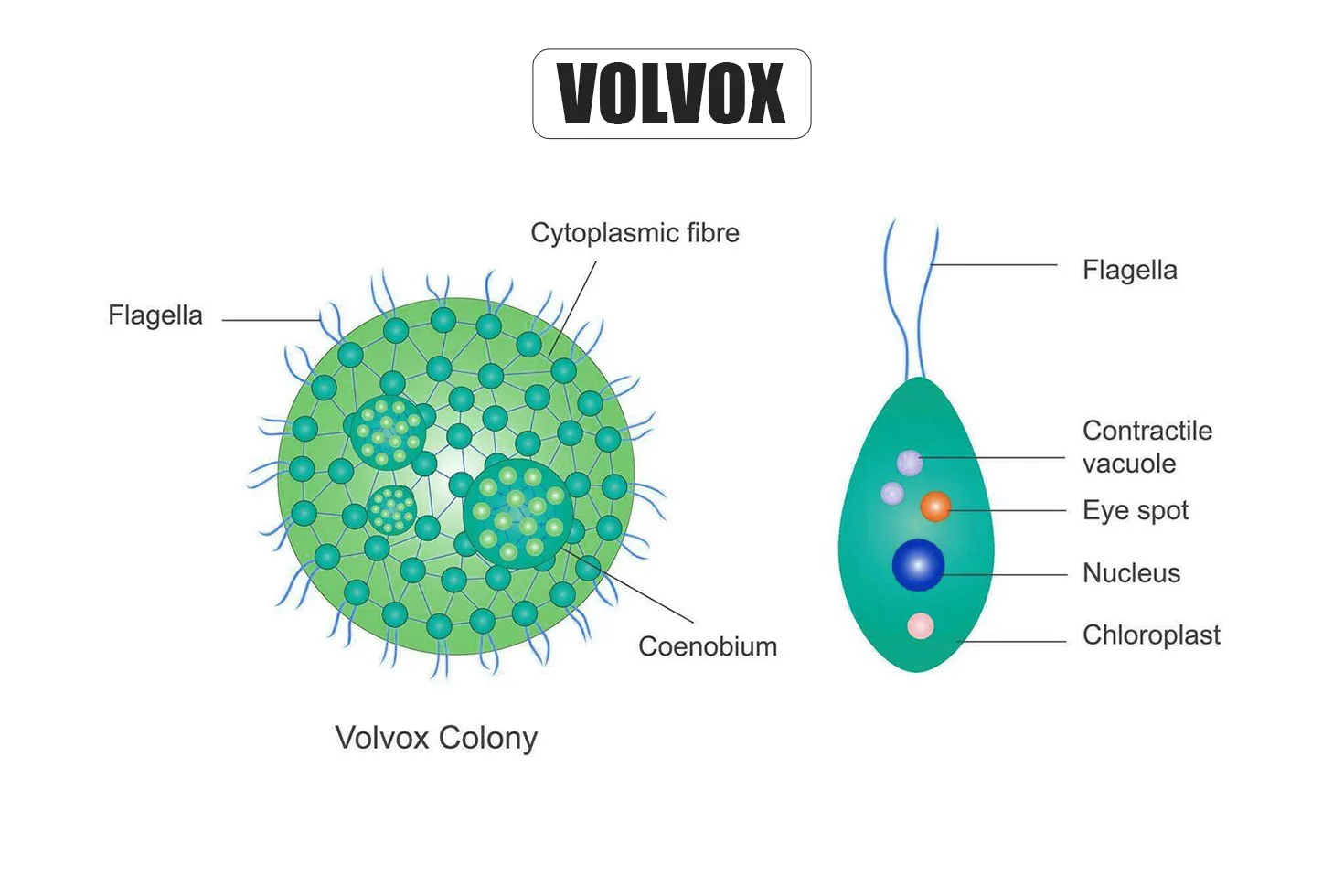
Volvox: Volvox is a polyphyletic genus of chlorophyte green algae in the family Volvocaceae. These organisms usually form spherical colonies of up to 50,000 cells, which is why they are known as "globe algae." Volvox belongs to a larger group of multicellular species known as volvocine algae. They have different body sizes, cell counts, and degrees of cell-type specialisation.
Volvox can be found in various freshwater environments and was first identified by Antonie van Leeuwenhoek in 1700. Volvox evolved from unicellular ancestors around 200 million years ago. Volvox detailed information is provided below for the benefit of NEET aspirants.Volvox Diagram
The following is a diagram of volvox:
Volvox Classification
Volvox is classified in the class Chlorophyceae because it contains chlorophyll. The following is the classification of volvox:| Volvox Classification | |
|---|---|
| Domain | Eukaryota |
| Kingdom | Plantae |
| Phylum | Chlorophyta |
| Class | Chlorophyceae |
| Order | Chlamydomonodales |
| Family | Volvocaceae |
| Genus | Volvox |
| Common Species | Volvox aureus, Volvox globator, V. carteri, V. barberi, and others |
Volvox Characterstics
Volvox is a type of green algae unique in its colonial structure. Here are some key characteristics:Volvox Structure
Volvox is a fascinating genus of green algae that exhibits a unique colonial structure, setting it apart from many other types of algae. These colonies, known as coenobia, are composed of numerous cells that work together in a coordinated manner to perform various functions. Here is a detailed look at the structure of Volvox:- Flagella: Each cell within a Volvox colony has two flagella, whip-like structures that protrude from the cell and are used for movement. The flagella beat coordinatedly, allowing the colony to move through the water.
- Nucleus: Volvox cells contain a nucleus, which houses the cell's genetic material and controls its activities.
- Chloroplasts: The cells of Volvox contain chloroplasts, which are responsible for photosynthesis. These chloroplasts are cup-shaped and contain pyrenoids, structures that help store starch.
- Eyespot: Some cells in Volvox colonies possess an eyespot, a light-sensitive organelle that helps the colony detect light direction.
- Contractile Vacuoles: Volvox cells also have contractile vacuoles, which regulate the cell's water content and maintain osmotic balance.
- Cellular Connections: The cells within a Volvox colony are interconnected by cytoplasmic strands. These strands allow for cell communication, enabling them to coordinate their activities.
Sexual Reproduction in Flowering Plants
Volvox Unicellular or Multicellular
Volvox is a multicellular organism that belongs to the genus of green algae. It is made up of thousands of cells working together as a colony. The individual cells are similar to those of unicellular algae but are multicellular due to how they are organized into different roles. This colonial structure is one major step forward in the evolutionary path towards multicellularity.Volvox Locomotion
Each non-reproductive cell in an individual's body possesses two flagella of equal size. These flagella exhibit a whip-like motion and are utilized for propulsion. The group can function as a single entity as these cells are interconnected through a jelly-like extracellular matrix. The speed at which the individual cells beat their flagella can alter the group's direction, akin to steering a canoe. If the person on the right paddles more vigorously, the canoe will veer to the left. Coordinated flagellar movements enable the colony to move in a specific direction, such as toward a light source (phototaxis).Volvox Reproduction
Volvox, a genus of freshwater green algae, exhibits a fascinating reproductive biology, involving both sexual and asexual modes of reproduction. These processes play crucial roles in the life cycle of Volvox, allowing it to adapt to changing environmental conditions and ensuring its survival.| Other NEET Biology Topics | ||
|---|---|---|
| Ribosomes | Pollination | Apomixis |
| Centrosome | Embryo | Tissues |
| Rhizopus | Pinus | Gluconeogenesis |
| Chlamydomonas | Chara | Ribs |
Asexual Reproduction in Volvox
- Cell Growth and Development: Asexual reproduction begins with cells on the posterior side of the coenobium, the colony of Volvox, undergoing significant growth, increasing in size nearly tenfold.
- Flagellar Withdrawal: As these cells grow, they withdraw their flagella, the whip-like appendages used for movement.
- Inward Movement: The enlarged cells, now called parthenogonidia, are pushed inside the colony during their development, leading to their separation from other cells due to their size and position within the coenobium.
- Cell Division: Each parthenogonidium undergoes multiple divisions, typically around 15, producing more than 3200 cells.
Sexual Reproduction in Volvox
Sexual reproduction in Volvox occurs mainly under unfavourable conditions, such as the approach of winter or other environmental stresses. Sexual reproduction in Volvox is always oogamous, producing large, non-motile female gametes (eggs) and smaller, motile male gametes (spermatozoa).Life Cycle of Volvox
Volvox life cycle is as follows:1.Sexual Reproduction Process:
- Oogonium Formation: All eggs are contained within specialized structures called oogonia, which also contain chloroplasts, giving them a greenish colour.
- Spermatozoon Production: Male gametes, or spermatozoa, are produced in antheridia. These spermatozoa are spindle-shaped and have a pair of apical cilia for movement.
- Fertilisation: Chemotactic movement attracts the spermatozoa to the oogonium, where a proteolytic enzyme breaks down the oogonium's wall, allowing the spermatozoon to enter. Only one spermatozoon is typically responsible for fertilising an egg.
- Zygote Formation: After fertilisation, a diploid zygote is formed, which turns red due to the presence of hematochrome, a red pigment.
- Cell Division: The zygote undergoes meiotic cell division to produce four haploid cells, which further divide through mitosis to form a new colony.
2. Asexual Reproduction Process:
- Gonad Production: Asexual reproduction involves the production of daughter cells, or gonads, through mitosis.
- Colony Formation: These daughter cells continue to divide, forming an invaginated colony within the parent colony.
- Release of Daughter Colonies: The daughter colonies eventually invert to form spheres and are released from the parent colony, completing the asexual reproduction process.
| NEET Exam Important Links | |
|---|---|
| NEET Biology Syllabus | NEET Biology Diagrams |
| NEET Biology MCQ | NEET Biology Chapter wise Weightage |
| NEET Biology Notes | NEET Previous Year Question papers |
Volvox FAQs
What makes Volvox unique?
Volvox stands out from unicellular organisms like Chlamydomonas due to its multicellularity and division of labor. Unlike Chlamydomonas, the somatic cells of Volvox cannot divide. This loss of reproductive capability in somatic cells is a key feature of Volvox's multicellularity. Instead of somatic cells, reproduction in Volvox is carried out by specialized cells called gonidia.
Is Volvox algae asexual?
Most Volvox species reproduce both asexually and sexually. Some species, such as Volvox carteri, switch between primary modes of reproduction at least once per year.
Who discovered Volvox?
Volvox, initially described as 'great round particles', was first observed by van Leeuwenhoek. In 1700, van Leeuwenhoek found these particles to be a delightful sight, initially mistaking them for small animals.
Is Volvox multicellular or unicellular?
Volvox carteri is a simple multicellular green alga that has recently evolved a basic division of labor with just two cell types: large germ cells called gonidia and small, specialized somatic cells.
Does Volvox have flagella?
Adult vegetative Volvox spheroids consist of approximately 2000 small, flagellated somatic cells and about 16 large, aflagellate germ cells called gonidia.
Do Volvox have eyes?
Volvox are in constant motion and can react to changes in light by turning swiftly. When exposed to light, the cells with eyespots near the light source cease flagellar movement, while active cells propel the Volvox towards the light. Volvox can coordinate these movements without a brain or nerve cells to connect them.
Talk to a counsellorHave doubts? Our support team will be happy to assist you!

Check out these Related Articles
Free Learning Resources
PW Books
Notes (Class 10-12)
PW Study Materials
Notes (Class 6-9)
Ncert Solutions
Govt Exams
Class 6th to 12th Online Courses
Govt Job Exams Courses
UPSC Coaching
Defence Exam Coaching
Gate Exam Coaching
Other Exams
Know about Physics Wallah
Physics Wallah is an Indian edtech platform that provides accessible & comprehensive learning experiences to students from Class 6th to postgraduate level. We also provide extensive NCERT solutions, sample paper, NEET, JEE Mains, BITSAT previous year papers & more such resources to students. Physics Wallah also caters to over 3.5 million registered students and over 78 lakh+ Youtube subscribers with 4.8 rating on its app.
We Stand Out because
We provide students with intensive courses with India’s qualified & experienced faculties & mentors. PW strives to make the learning experience comprehensive and accessible for students of all sections of society. We believe in empowering every single student who couldn't dream of a good career in engineering and medical field earlier.
Our Key Focus Areas
Physics Wallah's main focus is to make the learning experience as economical as possible for all students. With our affordable courses like Lakshya, Udaan and Arjuna and many others, we have been able to provide a platform for lakhs of aspirants. From providing Chemistry, Maths, Physics formula to giving e-books of eminent authors like RD Sharma, RS Aggarwal and Lakhmir Singh, PW focuses on every single student's need for preparation.
What Makes Us Different
Physics Wallah strives to develop a comprehensive pedagogical structure for students, where they get a state-of-the-art learning experience with study material and resources. Apart from catering students preparing for JEE Mains and NEET, PW also provides study material for each state board like Uttar Pradesh, Bihar, and others
Copyright © 2025 Physicswallah Limited All rights reserved.
Get App









